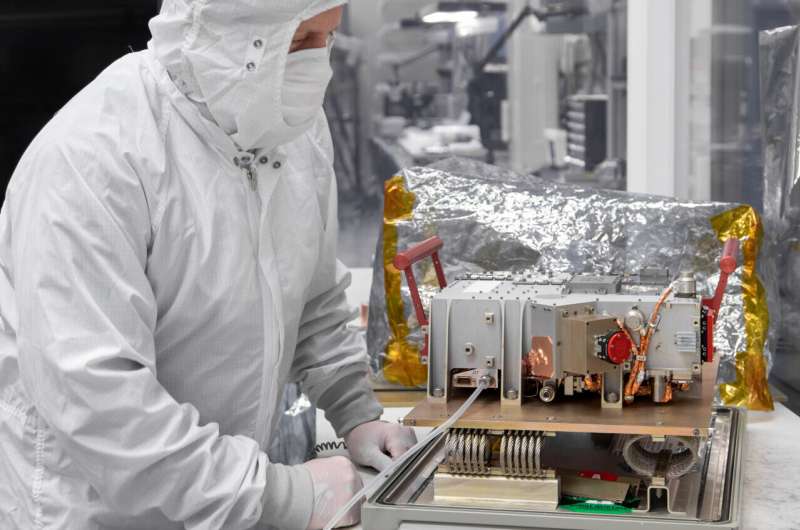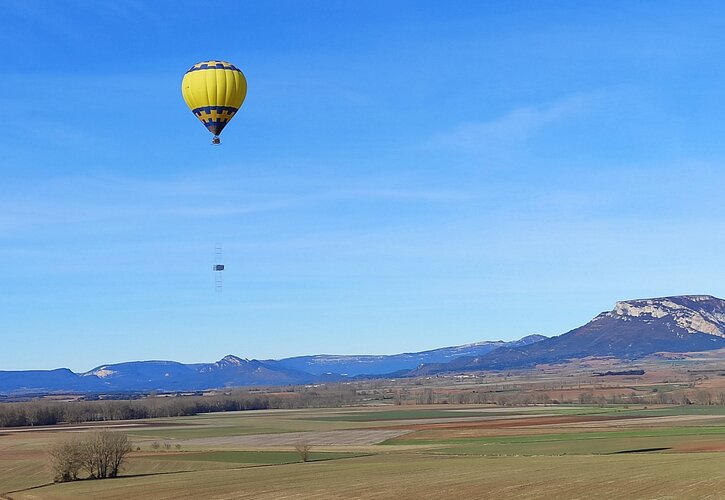
Copernical Team
Ultraviolet instrument to play integral part of NASA's Europa Clipper mission

An ultraviolet spectrograph (UVS) designed and built by Southwest Research Institute (SwRI) is the first scientific instrument to be delivered for integration onto NASA's Europa Clipper spacecraft. Scheduled to launch in 2024 and arrive in the Jovian system by 2030, Europa Clipper will conduct detailed reconnaissance of Jupiter's moon Europa and investigate whether it could harbor conditions suitable for life.
NASA begins assembly of Europa Clipper spacecraft

Science instruments and other hardware for the spacecraft will come together in the mission's final phase before a launch to Jupiter's icy moon Europa in 2024.
When it's fully assembled, NASA's Europa Clipper will be as large as an SUV with solar arrays long enough to span a basketball court—all the better to help power the spacecraft during its journey to Jupiter's icy moon Europa. And just about every detail of the spacecraft will have been hand-crafted.
The assembly effort is already underway in clean rooms at the agency's Jet Propulsion Laboratory in Southern California. Now, engineering components and science instruments are beginning to stream in from across the country and Europe.
Aerial antenna for Venus mission test
 Image:
Aerial antenna for Venus mission test
Image:
Aerial antenna for Venus mission test How scientists designed the aerodynamic configuration of Mars ascent vehicles?
 According to the white paper, China's Space Activities in 2016, the Mars sample return mission represents one of the main tasks to be implemented in China's deep space exploration field in the next 10 years. As the key technologies to be developed for Mars sample return, the design, analysis, and verification for Mars take-off and ascent can play a very important support role in the engineering
According to the white paper, China's Space Activities in 2016, the Mars sample return mission represents one of the main tasks to be implemented in China's deep space exploration field in the next 10 years. As the key technologies to be developed for Mars sample return, the design, analysis, and verification for Mars take-off and ascent can play a very important support role in the engineering Using artificial intelligence to find anomalies hiding in massive datasets
 Identifying a malfunction in the nation's power grid can be like trying to find a needle in an enormous haystack. Hundreds of thousands of interrelated sensors spread across the U.S. capture data on electric current, voltage, and other critical information in real time, often taking multiple recordings per second.
Researchers at the MIT-IBM Watson AI Lab have devised a computationally effi
Identifying a malfunction in the nation's power grid can be like trying to find a needle in an enormous haystack. Hundreds of thousands of interrelated sensors spread across the U.S. capture data on electric current, voltage, and other critical information in real time, often taking multiple recordings per second.
Researchers at the MIT-IBM Watson AI Lab have devised a computationally effi Northrop Grumman and Ball Aerospace to develop new missile warning system sensor
 Northrop Grumman and Ball Aerospace will design and develop the two mission payloads for the U.S. Space Force's Next Generation Overhead Persistent Infrared Polar (NGP) program.
"NGP combines Northrop Grumman's proven experience in missile warning and defense with Ball Aerospace's expertise in optical sensors and mission data processing," said Sarah Willoughby, vice president, overhead per
Northrop Grumman and Ball Aerospace will design and develop the two mission payloads for the U.S. Space Force's Next Generation Overhead Persistent Infrared Polar (NGP) program.
"NGP combines Northrop Grumman's proven experience in missile warning and defense with Ball Aerospace's expertise in optical sensors and mission data processing," said Sarah Willoughby, vice president, overhead per Lockheed Martin selects mission payload providers for missile warning satellite system
 Lockheed Martin has selected Raytheon Technologies to provide a second mission payload for the Next Generation Overhead Persistent Infrared Geosynchronous Earth Orbit Block 0 missile warning satellite system - also known as NGG. Both Raytheon Technologies and Northrop Grumman are each already on contract to provide one mission payload for the three-satellite procurement.
Lockheed Martin is
Lockheed Martin has selected Raytheon Technologies to provide a second mission payload for the Next Generation Overhead Persistent Infrared Geosynchronous Earth Orbit Block 0 missile warning satellite system - also known as NGG. Both Raytheon Technologies and Northrop Grumman are each already on contract to provide one mission payload for the three-satellite procurement.
Lockheed Martin is First Platforms are Retracted Ahead of Artemis I First Rollout to Launch Pad
 The Artemis I Moon rocket is getting closer to rolling out of the Vehicle Assembly Building (VAB) at NASA's Kennedy Space Center in Florida for the first time.
The first two of 20 platforms surrounding the Space Launch System (SLS) and Orion spacecraft that allow work on the integrated system inside the building were retracted for roll out to Launch Complex 39B. Teams retracted the platfor
The Artemis I Moon rocket is getting closer to rolling out of the Vehicle Assembly Building (VAB) at NASA's Kennedy Space Center in Florida for the first time.
The first two of 20 platforms surrounding the Space Launch System (SLS) and Orion spacecraft that allow work on the integrated system inside the building were retracted for roll out to Launch Complex 39B. Teams retracted the platfor Airbus Ventures invests in CesiumAstro's Series B
 Airbus Ventures proudly announces its investment in CesiumAstro Inc., a developer of advanced aerospace communication systems, which today publicized its $60 million oversubscribed Series B funding round, co-led by Airbus Ventures and Forever Ventures, with strategic participation from L3Harris Technologies (NYSE: LHX). Returning investors include Kleiner Perkins, Lavrock Ventures, Franklin Temp
Airbus Ventures proudly announces its investment in CesiumAstro Inc., a developer of advanced aerospace communication systems, which today publicized its $60 million oversubscribed Series B funding round, co-led by Airbus Ventures and Forever Ventures, with strategic participation from L3Harris Technologies (NYSE: LHX). Returning investors include Kleiner Perkins, Lavrock Ventures, Franklin Temp Fleet Space Technologies wins Australian Government grant to build space manufacturing hub
 Fleet Space Technologies is delighted to announce that the Australian Government has committed $20million (USD) to the development of the Space Manufacturing Hub in Adelaide, South Australia. This adds to funds already committed by The Government of South Australia ($20million AUS) and a consortium of leading space, aerospace and advanced air mobility companies including Fleet, Q-CTRL, AtSpace P
Fleet Space Technologies is delighted to announce that the Australian Government has committed $20million (USD) to the development of the Space Manufacturing Hub in Adelaide, South Australia. This adds to funds already committed by The Government of South Australia ($20million AUS) and a consortium of leading space, aerospace and advanced air mobility companies including Fleet, Q-CTRL, AtSpace P 
































